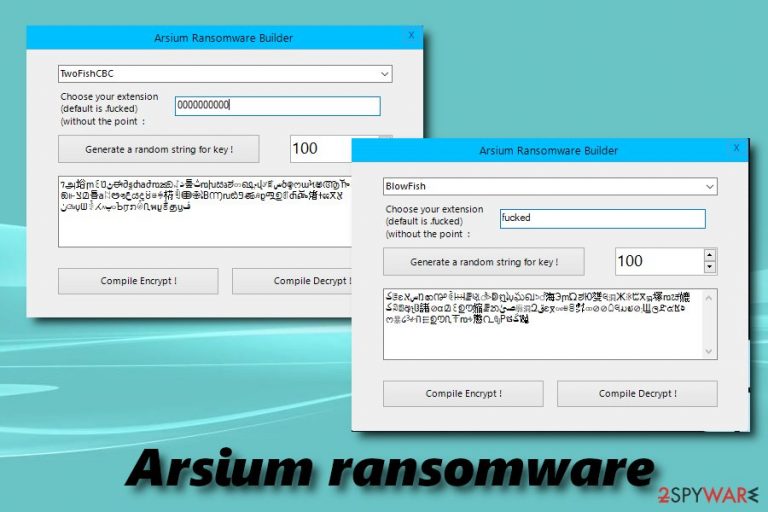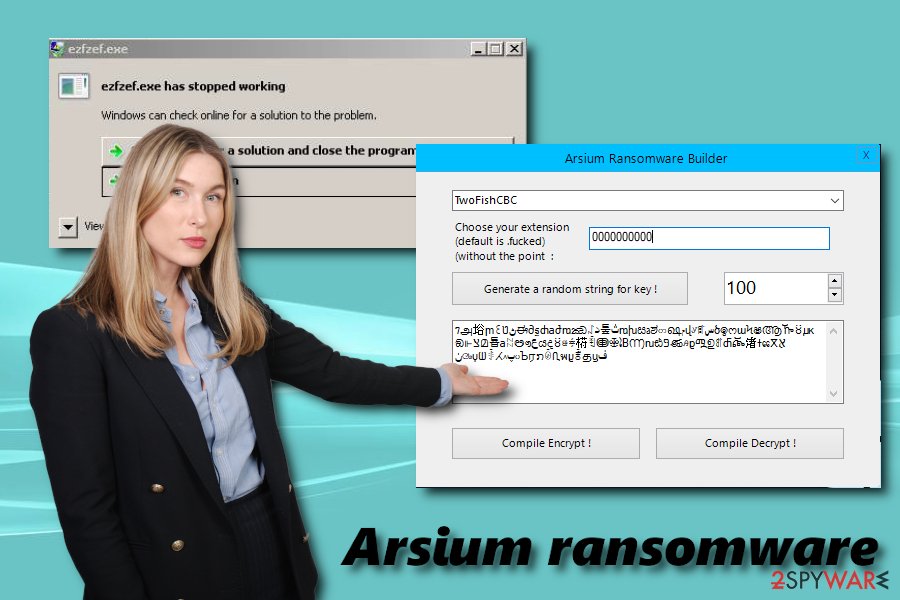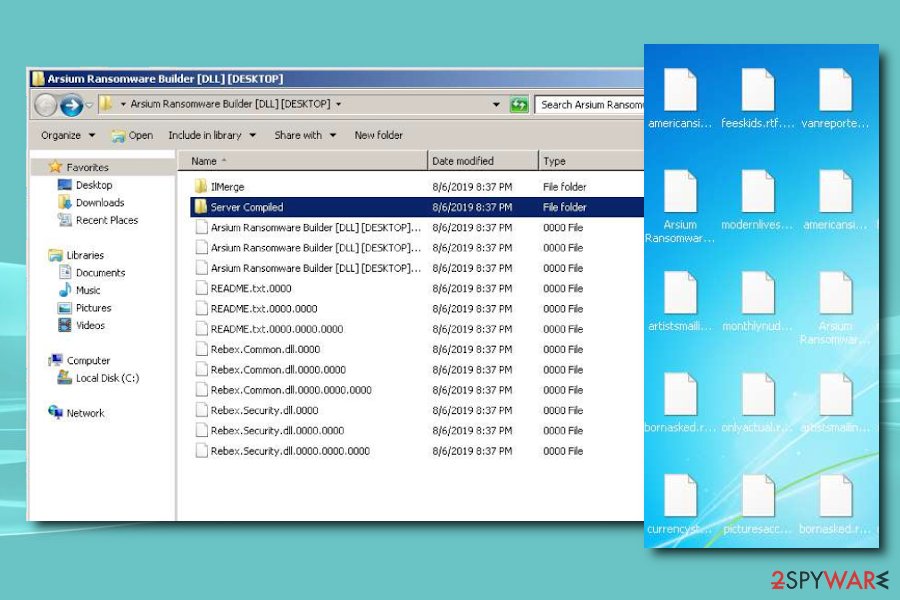Arsium ransomware (Quick Decryption Solution) - Removal Guide
Arsium virus Removal Guide
What is Arsium ransomware?
Arsium is a new ransomware building program that allows criminals to create their own ransomware threats

Arsium ransomware is a term used to describe a tool that has been compiled in order to create a unique ransomware virus. The post about it has been posted on a hacking forum called Nulled by a user “arsium” on 2nd of August, 2019.[1] As it turns out, the ransomware can currently encrypt data on desktop only, but the hacker claims that he/she will expand the functionality further.
Arsium ransomware offers to choose from a variety of encryption algorithms, such as RC4, AES, and many others. Such algorithms are typically used to encode all the files on the machine and prevent their access. Additionally, the files are appended with an extension, such as .encrypted or any other the bad actor might come up with (the default one offered by this builder is .fucked).
| Name | Arsium |
| Type | Ransomware builder |
| Peculiarities | Users can create their own ransomware viruses with a unique extension, name, etc. |
| Encryption algorithms | AES, RC4, Blowfish, etc. |
| Ransom size | Varies. Crooks can ask up to $5,000 or even more |
| Encrypted files | The virus currently encrypts data located on the desktop only |
| Decryptable? | No, data can only be recovered from backups or by using third-party software |
| Removal | Scan your computer with anti-malware software, such as FortectIntego or SpyHunter 5Combo Cleaner |
As soon as Arsium virus would encrypt data, it would also drop a ransom note that explains to users what happened to their computer and how to proceed next. Ransomware developers often offer free decryption of a few files that do not include important information in order to gain victims' trust. However, it is a well-known fact that hackers can bluff and never send you the decryptor. Just as with any other cryptovirus, experts[2] recommend staying away from malicious actors and rather proceeding with Arsium ransomware removal.
Encrypted files are not the only feature that Arsium ransomware has, however, Upon infection, the malware would also alter the way Windows operates and add new keys in the registry, download and install new files, create new processes, delete Shadow Volume Copies, and perform other system changes.
In such a way, the virus operation is ensured, and all the files that are added when the computer is infected would also be immediately encrypted. Therefore, it is vital to remove Arsium ransomware before using the computer for any reasons. Besides, some malware might be distributed with the help of trojans or backdoors, meaning that another infection might be lurking inside the PC.
In order to make sure that no other malware is involved and as well terminate the present one, you should scan your computer with FortectIntego, SpyHunter 5Combo Cleaner or any other reputable anti-virus software. After that, you could use backups to copy your files over or make use of third-party recovery software. We provide some examples at the end of this article.

Ransomware viruses can be spread in a variety of ways – learn to protect yourself
Ransomware is one of the most severe computer infections because the encrypted data usually cannot be recovered after its removal. Luckily, some of the infections might not function properly and fail to encrypt files or delete Shadow Volume copies (it is usually typical to ransomware that is still in development stages).
Nevertheless, the ramifications of ransomware infection can be devastating and extremely costly if it comes to the organizations. Some of the companies have to completely rebuild their IT infrastructure after the attack of a file locking malware – one of the best such examples is Maersk which paid around $300 million to recover from NotPetya attack.[3]
As evident, ransomware authors usually rely on sophisticated distribution methods, such as exploits, vulnerabilities, RDP, spam emails, and other methods in order to deliver the payload that starts the infection. However, it is possible to reduce the risk of the infection by following these simple tips:
- Install anti-malware software with real-time protection feature
- Enable Firewall
- Install ad-block
- Stay away from spam email attachments that ask for macro function to be enabled
- Use strong passwords for all your accounts and never reuse them
- Do not use default RDP port when connecting
- Stay away from software cracks and pirated programs
- Patch your computer with security updates
- Set automatic updates for all your installed applications.
Remove Arsium ransomware from your machine to use it normally again
Arsium ransomware removal is not only necessary to ensure that the computer is safe to use again, but also for a safe file recovery process. As we previously mentioned, all the files that are imported after the ransomware infection took place would be encrypted as well.

To remove Arsium ransomware, you need anti-malware software. While it is possible to delete the infection manually, it is not recommended for regular users, as the malware makes a great number of changes within the system. Be aware that some of the ransomware might try to disable or otherwise prevent security software from working. In case Arsium virus would try doing so, you should enter Safe mode with networking as explained below and perform a full system scan from there.
Getting rid of Arsium virus. Follow these steps
Manual removal using Safe Mode
If Arsium ransomware is tampering with your anti-malware software, you should access Safe mode with networking as follows:
Important! →
Manual removal guide might be too complicated for regular computer users. It requires advanced IT knowledge to be performed correctly (if vital system files are removed or damaged, it might result in full Windows compromise), and it also might take hours to complete. Therefore, we highly advise using the automatic method provided above instead.
Step 1. Access Safe Mode with Networking
Manual malware removal should be best performed in the Safe Mode environment.
Windows 7 / Vista / XP
- Click Start > Shutdown > Restart > OK.
- When your computer becomes active, start pressing F8 button (if that does not work, try F2, F12, Del, etc. – it all depends on your motherboard model) multiple times until you see the Advanced Boot Options window.
- Select Safe Mode with Networking from the list.

Windows 10 / Windows 8
- Right-click on Start button and select Settings.

- Scroll down to pick Update & Security.

- On the left side of the window, pick Recovery.
- Now scroll down to find Advanced Startup section.
- Click Restart now.

- Select Troubleshoot.

- Go to Advanced options.

- Select Startup Settings.

- Press Restart.
- Now press 5 or click 5) Enable Safe Mode with Networking.

Step 2. Shut down suspicious processes
Windows Task Manager is a useful tool that shows all the processes running in the background. If malware is running a process, you need to shut it down:
- Press Ctrl + Shift + Esc on your keyboard to open Windows Task Manager.
- Click on More details.

- Scroll down to Background processes section, and look for anything suspicious.
- Right-click and select Open file location.

- Go back to the process, right-click and pick End Task.

- Delete the contents of the malicious folder.
Step 3. Check program Startup
- Press Ctrl + Shift + Esc on your keyboard to open Windows Task Manager.
- Go to Startup tab.
- Right-click on the suspicious program and pick Disable.

Step 4. Delete virus files
Malware-related files can be found in various places within your computer. Here are instructions that could help you find them:
- Type in Disk Cleanup in Windows search and press Enter.

- Select the drive you want to clean (C: is your main drive by default and is likely to be the one that has malicious files in).
- Scroll through the Files to delete list and select the following:
Temporary Internet Files
Downloads
Recycle Bin
Temporary files - Pick Clean up system files.

- You can also look for other malicious files hidden in the following folders (type these entries in Windows Search and press Enter):
%AppData%
%LocalAppData%
%ProgramData%
%WinDir%
After you are finished, reboot the PC in normal mode.
Remove Arsium using System Restore
Try System Restore to delete the infection
-
Step 1: Reboot your computer to Safe Mode with Command Prompt
Windows 7 / Vista / XP- Click Start → Shutdown → Restart → OK.
- When your computer becomes active, start pressing F8 multiple times until you see the Advanced Boot Options window.
-
Select Command Prompt from the list

Windows 10 / Windows 8- Press the Power button at the Windows login screen. Now press and hold Shift, which is on your keyboard, and click Restart..
- Now select Troubleshoot → Advanced options → Startup Settings and finally press Restart.
-
Once your computer becomes active, select Enable Safe Mode with Command Prompt in Startup Settings window.

-
Step 2: Restore your system files and settings
-
Once the Command Prompt window shows up, enter cd restore and click Enter.

-
Now type rstrui.exe and press Enter again..

-
When a new window shows up, click Next and select your restore point that is prior the infiltration of Arsium. After doing that, click Next.


-
Now click Yes to start system restore.

-
Once the Command Prompt window shows up, enter cd restore and click Enter.
Bonus: Recover your data
Guide which is presented above is supposed to help you remove Arsium from your computer. To recover your encrypted files, we recommend using a detailed guide prepared by 2-spyware.com security experts.If your files are encrypted by Arsium, you can use several methods to restore them:
Data Recovery Pro might be able to help you
Data Recovery Pro is a tool that might be able to recover at least some of your lost files.
- Download Data Recovery Pro;
- Follow the steps of Data Recovery Setup and install the program on your computer;
- Launch it and scan your computer for files encrypted by Arsium ransomware;
- Restore them.
Make use of Windows Previous Versions feature
This method is only possible if you had System Restore enabled before ransomware struck.
- Find an encrypted file you need to restore and right-click on it;
- Select “Properties” and go to “Previous versions” tab;
- Here, check each of available copies of the file in “Folder versions”. You should select the version you want to recover and click “Restore”.
ShadowExplorer might be able to help you
In case Arsium virus failed to delete Shadow Volume Copies, using ShadowExplorer would recover all your data.
- Download Shadow Explorer (http://shadowexplorer.com/);
- Follow a Shadow Explorer Setup Wizard and install this application on your computer;
- Launch the program and go through the drop down menu on the top left corner to select the disk of your encrypted data. Check what folders are there;
- Right-click on the folder you want to restore and select “Export”. You can also select where you want it to be stored.
No decryptor is currently available
Finally, you should always think about the protection of crypto-ransomwares. In order to protect your computer from Arsium and other ransomwares, use a reputable anti-spyware, such as FortectIntego, SpyHunter 5Combo Cleaner or Malwarebytes
How to prevent from getting ransomware
Choose a proper web browser and improve your safety with a VPN tool
Online spying has got momentum in recent years and people are getting more and more interested in how to protect their privacy online. One of the basic means to add a layer of security – choose the most private and secure web browser. Although web browsers can't grant full privacy protection and security, some of them are much better at sandboxing, HTTPS upgrading, active content blocking, tracking blocking, phishing protection, and similar privacy-oriented features. However, if you want true anonymity, we suggest you employ a powerful Private Internet Access VPN – it can encrypt all the traffic that comes and goes out of your computer, preventing tracking completely.
Lost your files? Use data recovery software
While some files located on any computer are replaceable or useless, others can be extremely valuable. Family photos, work documents, school projects – these are types of files that we don't want to lose. Unfortunately, there are many ways how unexpected data loss can occur: power cuts, Blue Screen of Death errors, hardware failures, crypto-malware attack, or even accidental deletion.
To ensure that all the files remain intact, you should prepare regular data backups. You can choose cloud-based or physical copies you could restore from later in case of a disaster. If your backups were lost as well or you never bothered to prepare any, Data Recovery Pro can be your only hope to retrieve your invaluable files.
- ^ ARSIUM RANSOMWARE BUILDER [DLL] [DESKTOP]. Nulled. Hacking forums.
- ^ Novirus.uk. Novirus. Cybersecurity research from the UK.
- ^ Lee Mathews. NotPetya Ransomware Attack Cost Shipping Giant Maersk Over $200 Million. Forbes. American business magazine.







